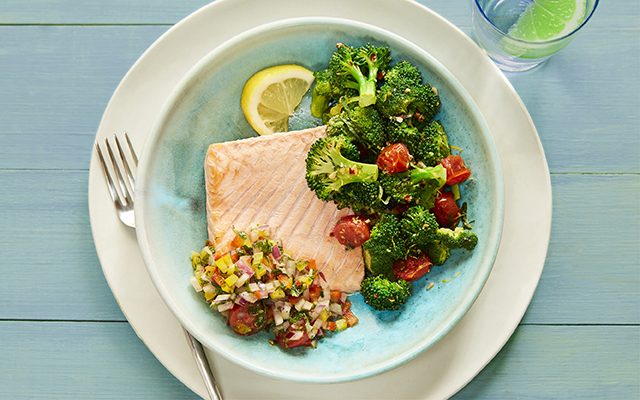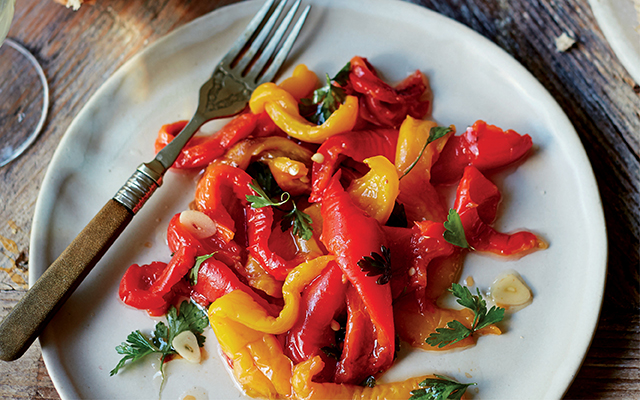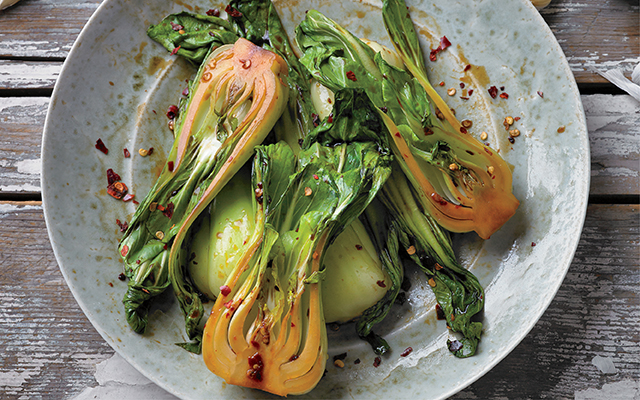The jalapeño provides a warm and welcoming introduction for people who want to learn more about cooking with chilies. They’re not crazy hot like a habanero or cautiously cool like a bell pepper. They’re somewhere in the middle, providing the perfect balance between yikes! and yawn.
Aside from invigorating your taste buds, the jalapeño — generally green in the summer and red in the autumn — offers a seductive contrast to both sweet and salty foods. Psychologist Paul Rozin claims that eating chilies is a bit like riding a roller coaster; both are forms of “constrained risk,” letting people enjoy extreme sensations like pain and fear without experiencing any real harm.
Don’t think of the jalapeño as the ultimate Six Flags ride, though. It’s more like a culinary version of the tilt-a-whirl. The fact that chilies are the most widely grown spice in the world is proof that everyone likes a little thrill, especially in the kitchen.
Nutrition Know-How
- The phytochemical capsaicin, which is the source of the chili pepper’s heat, is a potent anti-inflammatory agent. Capsaicin inhibits substance P, a neuropeptide associated with inflammation, and is a common ingredient in pain-relieving formulas for inflammatory-related conditions, such as rheumatoid arthritis and joint pain.
- Capsaicin also increases circulation and reduces cholesterol. In places where people eat more chilies, there are lower rates of heart attack, stroke and pulmonary embolism. Capsaicin further increases the body’s metabolic rate and helps clear congestion.
- Chilies are mistakenly thought to cause ulcers. In fact, capsaicin has antibacterial properties that help prevent ulcers.
- In addition to being a good source of dietary fiber and a wide range of vitamins and minerals, chilies are also loaded with cancer-fighting antioxidants.
- Like tomatoes, potatoes and eggplant, chilies belong to the nightshade family, which contains alkaloids. So if you are sensitive to nightshade plants, be aware that chilies (and other peppers) may prove problematic for you.
- Also avoid hot peppers if you have gastroesophageal reflux disorder or irritable bowel syndrome.
Kitchen Tricks
- When handling jalapeños, wear latex or other protective gloves. If you do wind up touching chilies, remember that their oils stay on your skin for a while, so avoid rubbing sensitive skin or touching your eyes.
- Leaving in the seeds and ribs increases the potency of chilies. Removing them will mellow out the heat but still deliver all the flavor.
- It’s smart to test a pepper’s heat before you eat it or mix it into a dish. Cut a tiny piece, pick it up with a fork and touch it to your tongue, then decide how much you want to use.
- If you bite into a piece of pepper that leaves your tongue on fire, resist the temptation to gulp water. Water just spreads the heat around, much like it does with a grease fire. Carbonation, too, adds to irritation. Instead, try something rough and bland (think crackers or crusty bread), or put a little sugar on your tongue. The sucrose will help calm down the capsaicin.
Shopping and Storage Tricks
- Look for jalapeños with firm, fresh skin. Unlike other chilies, however, it’s OK if there are dry wrinkles near the jalapeño’s stem; that generally indicates extra heat.
- Store jalapeños in a paper bag in the crisper drawer of the refrigerator.
- Preserve jalapeños by removing seeds and ribs and drying in a 130- to 150-degree F oven for four to seven hours.
Quick and Easy
- Add small-diced roasted (or raw) jalapeños to salads, soups, sauces, sandwiches and egg dishes for a flavor boost and a kick of heat.
- Grill jalapeños whole to serve with barbecue, fajitas and grilled chicken.
- Spike some vinegar with sliced jalapeños and a little garlic for your own homemade hot sauce to drizzle over meat and beans, and into soups and salsas.
- Use chipotles (smoke-dried jalapeños) in adobo sauce to add smoky heat to dishes. Remember: A little goes a long way.
The Heat Index
Here’s a guide to the most common peppers commercially available, with their Scoville rating (which measures chilies’ heat). The higher the number on the Scoville scale, the more capsaicin a chili has — and the hotter it is. As a rule of thumb, the smaller the chili, the hotter it is likely to be.
- Habanero (Exceptionally Hot: 100,000–350,000) The habanero is extremely hot and rather fruity, and a little goes a very long way. If you can stand the heat, it’s great for homemade hot sauces and salsas (although beginners should probably steer clear of this fiery chili).
- Serrano (Hot: 10,000–25,000) With a bright, crisp taste — and a bite — the serrano is typically eaten raw. Because they have thin walls, you don’t have to steam, char or peel serranos before using them. Enjoy in pico de gallo.
- Jalapeño (Medium: 2,500–8,000) With its peppery kick, the jalapeño is perfect for adding heat to most dishes. Use it in salsas, sauces and salads. Smoked jalapeños are called chipotle peppers; they are found canned in adobo sauce. Use chipotles in salsas, sauces, marinades and dressings where you want some heat and smoky flavor.
- Poblano (Mild: 1,000–1,500) Once in a while you can get a poblano with a little more kick, but it usually has a mild flavor. The heart-shaped poblano is sweeter and a wee bit hotter than most Anaheims. It is also more tender, making it perfect for salsa, for stuffing, and for cooking as a base for green chili or tomatillo sauce.
- Anaheim (Mild: 500–2,500) A mild, large chili that’s perfect for stuffing, the Anaheim has tough skin, so you need to remove it before eating. Char the chili over a flame, let it steam in a sealed paper bag, then peel the skin. Great for use in chili rellenos and other Mexican and New Mexican dishes.
- Banana (Mild: 0–500) Often confused with the yellow wax pepper, which is hotter, the banana pepper is often served pickled — as is another mild chili, the pepperoncino (pepperoncini is the plural form of the word).
- Bell (Mild: 0) The mildest chili, bell peppers start out green and ripen on the vine to red, yellow, orange and purple varieties — which is why the green bells are not as sweet as the others. Good raw in salads, sautéed for stir fries or fajitas, in soups, and as toppings for all types of sandwiches. Try mixing up colors for variety in appearance and taste.
Grilled Stuffed Jalapeños
A healthy spin on deep-fried jalapeño poppers, this festive recipe will be a big hit on the grill.
Makes eight servings
Ingredients
- 16 jalapeños
- ½ cup shredded sharp cheddar cheese
- ½ cup shredded Monterey Jack cheese
- 1 cup canned black beans, drained and rinsed
- 2 tbs. chopped green onions
- ½ tsp. minced fresh garlic
- ½ tsp. ground cumin
- ½ tsp. chili powder
Directions
- In a mixing bowl, combine all the ingredients except the peppers. Make a lengthwise slit down each pepper, leaving the stem intact; carefully remove ribs and seeds. Fill each pepper with 1 tablespoon cheese and bean mixture.
- Heat your grill on one side to medium-high heat and leave the other side unheated. You will be cooking the peppers with indirect heat. Place the peppers on a sheet of aluminum foil and place on cool side of the grill. (If you have a gas grill, simply leave one of the burners unlit and this will be your cooking area.)
- Cover grill and cook for eight to 12 minutes or until the peppers have softened and the cheese has melted. (You can also broil the peppers in an oven.)
Pineapple Avocado Salsa
Jalapeños bring depth and subtle heat to this sweet and savory salsa, which can be simply paired with good-quality chips or used as a topping for grilled chicken or pork. Turn this salsa into a salad by adding black beans, grilled corn and steamed brown rice. Depending on your heat threshold, poblano, serrano and habanero chilies could all work well in this salsa. You can even use bell peppers if you want a mild salsa with no kick.
Makes 7 cups
Ingredients
- 1 fresh pineapple, chopped into ¼-inch pieces
- 2 medium avocados, ripe, chopped into ½-inch cubes
- ½ cup chopped red onion
- ¼ cup chopped fresh cilantro
- 1 tbs. minced jalapeño, deseeded
- ¼ cup fresh lime juice
- ¼ cup fresh orange juice
- 2 tbs. extra-virgin olive oil
- Sea salt
Directions
- Stir all ingredients together and season with salt to taste.
Crispy Jalapeño Slaw
Combined with a light lime vinaigrette, the vegetables in this slaw stay crisp. The jalapeño will mellow out as the salad marinates. A combination of chilies, such as banana, Anaheim and poblano, can be used in this recipe as well. Try adding this slaw to fish tacos or burritos, or serve as a side to a turkey or veggie burger.
Makes six servings
Ingredients
- 4 cups shredded cabbage (any kind)
- 1 cup julienned jicama
- ½ cup julienned red peppers
- ½ cup julienned jalapeño peppers (remove seeds and ribs if you like your salad less hot)
- ½ cup chopped fresh cilantro
- ¼ cup extra-virgin olive oil
- 2 tbs. lime juice
- ½ tsp. chili powder
- ½ tsp. sea salt
Directions
- Combine the cabbage, jicama, red peppers, jalapeño and cilantro in a mixing bowl. In a small bowl, whisk together the oil, lime juice, chili powder and salt. Pour the dressing over the salad and mix well. Refrigerate for at least one hour before serving.
Roasted Jalapeño Honey Butter
Smoky heat from roasted jalapeños paired with sweet honey creates a taste sensation that kicks up the flavors in butter. Try this spread on grilled corn on the cob or brushed over grilled chicken breasts.
Makes 1 ½ cups
Ingredients
- 2 jalapeños
- 2 sticks of butter, room temperature
- ¼ cup honey
Directions
- Place the jalapeños on a heated grill or under a broiler in the oven, cook until charred on all sides, then place in a mixing bowl and cover. Let rest for five minutes. Remove the skin, ribs and seeds. Chop jalapeños into ¼-inch dice.
- Whip the butter, honey and jalapeños with an electric mixer until light and fluffy. Store in an airtight container for up to one week in the refrigerator.
Jalapeño Garlic Vinegar
Vinegar infused with jalapeño adds a complex kick to homemade dressings or BBQ sauce. Try splashing it in salsa or drizzle over beans. If you really love the heat, try making this infusion with cayenne or habanero peppers.
Makes 2 cups
Ingredients
- 2 cups seasoned rice vinegar (found at Asian stores and most natural food stores)
- 1 jalapeño, sliced in quarters
- 1 garlic clove, thinly sliced
Directions
- Sterilize a glass container by either submerging it in boiling water for five minutes or running it through the dishwasher.
- In a small saucepan, heat the vinegar to a simmer.
- Place the remaining ingredients into the sterilized container. Using a funnel, slowly pour the vinegar into the container and let cool.
- Seal tightly and store at room temperature for at least 48 hours and up to one week prior to serving. When ready, strain vinegar and store in a clear, sterilized jar in a cool dry place for up to two months.
Originally appeared as “The Heat Is On” in the June 2011 issue of Experience Life.



